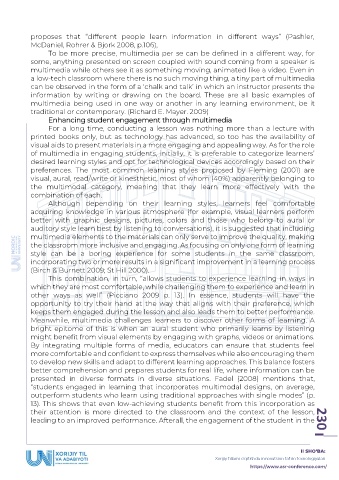Page 232 - Konferensiya to'plami - 1 (ASR)
P. 232
proposes that “different people learn information in different ways” (Pashler,
McDaniel, Rohrer & Bjork 2008, p.106),
To be more precise, multimedia per se can be defined in a different way, for
some, anything presented on screen coupled with sound coming from a speaker is
multimedia while others see it as something moving, animated like a video. Even in
a low-tech classroom where there is no such moving thing, a tiny part of multimedia
can be observed in the form of a ‘chalk and talk’ in which an instructor presents the
information by writing or drawing on the board. These are all basic examples of
multimedia being used in one way or another in any learning environment, be it
traditional or contemporary. (Richard E. Mayer. 2009)
Enhancing student engagement through multimedia
For a long time, conducting a lesson was nothing more than a lecture with
printed books only, but as technology has advanced, so too has the availability of
visual aids to present materials in a more engaging and appealing way. As for the role
of multimedia in engaging students, initially, it is preferable to categorize learners’
desired learning styles and opt for technological devices accordingly based on their
preferences. The most common learning styles proposed by Fleming (2001) are
visual, aural, read/write or kinesthetic, most of whom (40%) apparently belonging to
the multimodal category, meaning that they learn more effectively with the
combination of each.
Although depending on their learning styles, learners feel comfortable
acquiring knowledge in various atmosphere (for example, visual learners perform
better with graphic designs, pictures, colors and those who belong to aural or
auditory style learn best by listening to conversations), it is suggested that including
multimedia elements to the materials can only serve to improve the quality, making
the classroom more inclusive and engaging. As focusing on only one form of learning
style can be a boring experience for some students in the same classroom,
incorporating two or more results in a significant improvement in a learning process
(Birch & Burnett 2009; St Hill 2000).
This combination, in turn, “allows students to experience learning in ways in
which they are most comfortable, while challenging them to experience and learn in
other ways as well” (Picciano 2009 p. 13). In essence, students will have the
opportunity to try their hand at the way that aligns with their preference, which
keeps them engaged during the lesson and also leads them to better performance.
Meanwhile, multimedia challenges learners to discover other forms of learning. A
bright epitome of this is when an aural student who primarily learns by listening
might benefit from visual elements by engaging with graphs, videos or animations.
By integrating multiple forms of media, educators can ensure that students feel
more comfortable and confident to express themselves while also encouraging them
to develop new skills and adapt to different learning approaches. This balance fosters
better comprehension and prepares students for real life, where information can be
presented in diverse formats in diverse situations. Fadel (2008) mentions that,
“students engaged in learning that incorporates multimodal designs, on average,
outperform students who learn using traditional approaches with single modes” (p.
13). This shows that even low-achieving students benefit from this incorporation as
their attention is more directed to the classroom and the context of the lesson,
leading to an improved performance. Afterall, the engagement of the student in the 230
II SHO‘BA:
Xorijiy tillarni o‘qitishda innovatsion taʼlim texnologiyalari
https://www.asr-conference.com/

